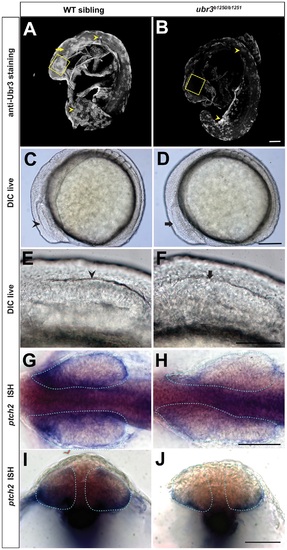- Title
-
Ubr3, a Novel Modulator of Hh Signaling Affects the Degradation of Costal-2 and Kif7 through Poly-ubiquitination
- Authors
- Li, T., Fan, J., Blanco-Sánchez, B., Giagtzoglou, N., Lin, G., Yamamoto, S., Jaiswal, M., Chen, K., Zhang, J., Wei, W., Lewis, M.T., Groves, A.K., Westerfield, M., Jia, J., Bellen, H.J.
- Source
- Full text @ PLoS Genet.
|
Ubr3 is required for Hh signaling and proper optic vesicle morphogenesis. (A-B) Lateral views of zebrafish embryos at 18-somites stage after removing the yolks, labeled with anti-Ubr3 antibody. Boxes outline the zebrafish retina, arrow points to central nervous system. The remaining signal in ubr3b1250/b1251 mutant corresponds to non-specific autofluorescence emanating from the yolk and some peridermal cells (arrowheads). (C-D) DIC (Differential Interference Contrast) imaging showing lateral views of 6-somites stage zebrafish embryos. (C) Wild-type optic vesicle (arrowheads) is morphologically visible and characterized by a stratified epithelial thickening. The cavitation seam divides the presumptive retina into dorsal and ventral halves. (D) ubr3 trans-heterozygous mutant optic vesicle (arrow) has morphological defects characterized by disorganized tissue that lacks epithelial morphology. The cavitation seam is disrupted or absent. (G-J) In situ hybridization for ptch2 in wild-type (G, I) and ubr3 mutant (H, J) zebrafish embryos. Note the down-regulation of ptch2 in ubr3 mutant optic vesicles (dotted area). Dorsal views of flat-mounted zebrafish embryos. (G, H) Cross sections through the optic vesicle of embryos shown in G and H, respectively. All the scale bars represent 50µm. EXPRESSION / LABELING:
PHENOTYPE:
|
|
ubr3 is required for Hedgehog (Hh) signaling in zebrafish. (A, C) DIC images show lateral views of posterior trunk regions at 24-hours-post-fertilization. Anterior to the left, dorsal up. The angles of V-shaped somites were shown by the red line. Scale bars: 50µm. (B, D) islet2 in situ hybridization (ISH) of wild type and ubr3b1250/1251 mutant zebrafish. Lateral views of posterior trunk regions at 24-hours-post-fertilization are shown. (E) Average somite angle in wild-type siblings (wt sibs) and ubr3b1250/b1251 trans-heterozygous mutants. Wild type siblings have a typical V-shaped somite characterized by an average angle of 92°. In the ubr3 trans-heterozygous mutants, the angles become more obtuse with an average of 119°. (F-I) ISH against ubr3 at 24 and 28 hpf. Lateral views of the somites. (F-G) At 24 hpf (F), ubr3 is expressed throughout the somites. By 28hpf (G), this expression is restricted to ventral regions of the somites (red bracket). (H) ubr3 expression is lost in smo mutants at 24 hpf. (I) At 28 hpf, the ubr3 expression domain is expanded dorsally when Hh signaling is upregulated by ectopic expression of dnPKA (green bracket). Bars: SEM. Five angles were measured per larva. Five heterozygous and seven ubr3b1250/b1251 larvae were analyzed, P<0.01. |


